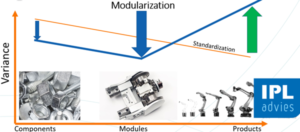Hierbij verwelkomen we onze nieuwe collega Franc Magnée.
Wij wensen Franc veel succes in het ondersteunen van klanten in de maakindustrie met Smart Customization.

Franc heeft een mechatronische achtergrond en heeft de afgelopen 20 jaar ervaring opgedaan in de machinebouw van verpakkingsmachines. Zijn ervaring is heel divers en kent daardoor alle aspecten van dit soort organisaties. Franc heeft leiding gegeven aan de technische afdelingen, de operationele afdelingen, supply chain, maar ook aan sales en project management.
Centraal binnen zijn ontwikkeling staat het structureel verbeteren van een organisatie en optimaliseren van processen op basis van een duidelijke visie. Meenemen van mensen in deze processen vindt hij van groot belang.
De afgelopen jaren heeft Franc vanuit het management team, met de rol als productmanager, gewerkt aan het opzetten van een mechatronisch modulaire productstructuur. Samen met een team van standaardisatie engineers heeft hij een aantal machine families configureerbaar heeft gemaakt.
Binnen IPL zal Franc dan ook bedrijven gaan helpen met de transformatie van ETO naar Smart Customization.





 Wij gaan samen met het team van Defenture de processen “future proof” maken om klaar te zijn voor de verdere groei in producten, klanten, diensten en projecten.
Wij gaan samen met het team van Defenture de processen “future proof” maken om klaar te zijn voor de verdere groei in producten, klanten, diensten en projecten.




